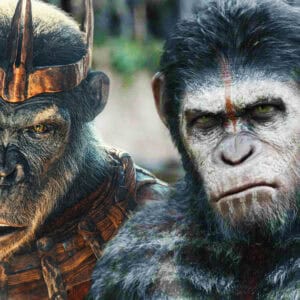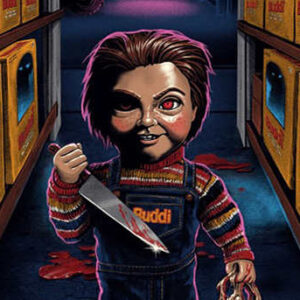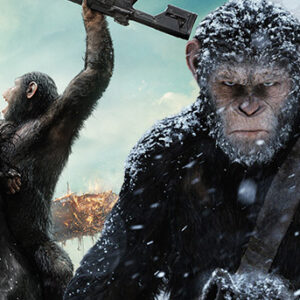Last Updated on July 31, 2021

Above my head and all around us, the grey, cloud-choked sky began to darken. Then, in what precious light was left in the evening sky, I saw what looked like two humanoid robots making their way toward the sanctuary of our heated press tent. With cheshire grins stretched across their dotted faces, actors Andy Serkis and Terry Notary arrived in full motion capture regalia. As they each pulled up a chair, I marveled at the complexity of their attire. I first noted that both men were dressed from head to toe in what can only be described as a gray, tightly hooded onesie. Strategically placed along their chests, legs, and arms were a series of motion-capture dots; each plotted point able to be recognized and manipulated by special cameras.
Next, I took note of a gathering of wires that lined their extremities; each path eventually connecting to a cluster of battery packs affixed along Andy and Terry’s spines. Finally, I observed what looked like an advanced Go-Pro camera, stemming from the occipital portion of their skulls and pointed back at them, dutifully recording their every facial tick and elaborate expression. After gathering a bit of food from the crafts service table, both Andy and Terry tucked into their modest portions of sustenance and began speaking about their experiences while filming WAR FOR THE PLANET OF THE APES.

INTERVIEW WITH ANDY SERKIS & TERRY NOTARY
How are you taking things to the next level with this film, visually speaking?
Terry: “WETA’s constantly developing new tools and procedures to render fur and things like that more efficiently. They’ve developed a new fur pipeline that wasn’t utilized on DAWN, but will be on this movie. [This new program] is more about real-time lighting and efficiencies in the fur. We rebuild the characters with each film. Typically, we keep the same designs but we use the new tools each time to fine-tune the designs.”
Can you share with us any new challenges that presented themselves when shooting in snow-covered locations?
Terry: “Yeah, the snow presented a huge challenge for us. Our characters are digital, and they’re played by humans, so that introduces the very nature of their footfalls being different, their gait, and using crutches instead of hands. Every time the apes are walking in snow, that path has to be digitally recreated. We basically have to erase all the human footfalls and replace them with that of an apes. Additionally, what snow looks like when it’s balled up and icy on the tips of fur, that’s a whole new challenge in figuring out what that’s going to look like. On the last movie, we had a lot of breakthroughs with wet fur, and on this film we’re really taking the ball and running with it. Just before we finished the last movie, Matt walked up to me and said, “Next time, apes in the snow.”; and then he walked away.”
How do you manage the consistency of the effects?
Terry: “All of the data regarding the details of the world is collected: the lighting, the weather, the wetness. Then, as the shots are put together and the worlds are built, we know what elements will affect the characters and those conditions are then applied across the board. We very carefully track all of the details of the environment. That way, when we put our apes into the real environment, it’s a matter of tracking all of those details and re-creating them with CG.”
Has working with the CG technology gotten any easier as you progress through the franchise?
Terry: “The scope of this movie is so much larger than the last movie. It’s like, as soon as you figure out one piece of the puzzle there’s a whole other puzzle waiting for you around the corner. In scope and scale, 65mm presents a challenge in terms of that you have a huge image plain to deal with, which also has a very shallow depth of field. When you’re talking about inches of depth-to-field margin it’s difficult to get all the details of the CGI to marry in.”
How much of the film is presented in exterior shots as opposed to indoor locales?
Terry: “If I were to throw a number at it, I’d say probably 70% of the movie is exterior. I think that out of 80 shooting days we’re on stage for 15 of them. We do have one digital set that is an all-apes space. Having the set be digital means that we can have it be bigger and more expressive without having to create a hammer-and-nails build.”
Because it’s not a natural habitat for apes to be in the snow, how did you go about interpreting the behavior of the species in those conditions?
Terry: “We rely heavily upon the performance of the actors versus the physiology of real apes. We definitely try to stay true to the anatomy and the biology of an ape, but if Andy Serkis performs in such a way that an ape really wouldn’t, we’ll follow Andy more than we would the ape. So what we do is, we put Andy in the snow, and see what he does. We shot a bit on Mount Seymour, to where the snow is quite deep and it’s really cold. So, when they’re quadropeding through the snow the physics of that translates through their performance, and we just match that. In terms of what the environmental impact of an ape would be, we’ll reference other animals that live in the snow to see how the ice balls up on their fur and use that inform how the elements would affect the apes.”
How do you go about creating CGI environments that don’t look fake on-screen?
Terry: “The Tower in the last movie was all digital as well. What we learned from that was, that it was an entirely digital space that did not connect to anything in our set world in terms of that it was totally different. In this one, the ape world that we’re creating all digitally has three counterpart sets that are made up of the same materials that we actually are building. So, we’ll have an entire list of references in which to build our CGI world. If we do our jobs correctly, it will be a complete one-to-one match of the real references to the point of which you won’t even be able to tell the difference.”
How much are live apes still a part of the filmmaking process?
Terry: “They’re referenced constantly. WETA has a great relationship with the Wellington Zoo and they’ve become a part of the family, really. If there’s a special event scheduled for the apes, Wellington will actually contact WETA so that a representative can record the data of that activity or whatever and use it as reference material for the film. On DAWN, they had to put a chimp under sedation for a medical procedure, so they called up WETA, and WETA did plaster molds of the hands and things like that. WETA then took that info to a high-res laser scanner and scanned all those textures and things like that. There’s never a reason to bring the apes on set, it’s all done over at Wellington. We’ve never had a live ape on any of our sets, for all three movies.”
What has it been like to render the apes for 65mm and 4K resolution?
Teryy: “We’re rendering at 2K with a procedural uprez to 4K. Rendering these apes at 2K is thirty to forty hours per frame, so even starting the subject of rendering them at 4K or the native resolution of 65, is madness. We’d have to add another year to the filmmaking process alone to do that.”
Do you have a strategy in how you plan to feature the continued evolution of the characters?
Terry: “We’re definitely seeing that they’re walking more upright, the locomotion is getting more and more human with each movie. We’re taking small steps with each installment to the franchise. Speech and things like that, Andy is more comfortable doing that while others are sticking with the use of sign language. They’re communication and the way they live is certainly evolving, as well as their needs and wants. We’re starting to bring together the behaviors that we’re going to take over the world.”
Are there any new characters that you’re looking forward to seeing in the new film?
Terry: “I’m very excited about Steve Zahn's character. His is a new lead character that will be taking some evolutionary steps forward. He’s a lot of fun and will add an element of levity to a pretty grim world. The design that we’ve come up with for his character, I think, is wonderful, and I think the fans are really going to love him.”

Where is Caesar at, physically and emotionally, as we enter into this new film?
Andy: “At this point in Caesar’s journey, if you remember where we left off in the last film, the apes have become divided under the leadership of Koba. As a result, Caesar was carrying an enormous amount of guilt at killing and going against one of the primary tenants of their belief structure which is: Ape does not kill ape.
Two years have passed, the ALC drug has allowed Caesar to continue to develop, and he’s now living in a situation where both apes and humans are at war. Both sides are understandably weathered and worn. Caesar has had to lead his ape followers away and into the hills and set up a temporary base. Following the decision to flee, an event happens at the beginning of this movie that sets him off on a track that almost eats him up. As a result, Caesar goes off on a revenge mission of sorts. In this film, he ends up going through this sort of voyage of self destruction, almost, and is then forced to claw his way back from that very dark place. By the end, he’s able to redeem himself and lead the exodus of the apes to freedom.
What we’ve managed to do, each time, is amplify the stakes, emotionally, in order to create something massive. The global understanding of the apes is bigger this time out. They understand that there are other apes outside of the smaller group in Meer Woods who are evolving, and how much the virus is affecting humanity. Where Caesar is physically and emotionally is he is now a wartime leader. He’s carrying and bearing that weight at the beginning of the movie. Physically, he’s much more upright, much more human-like. Linguistically, he’s much more fluent. Throughout the films we’ve seen Caesar sign and slowly adapt to using human speech. Now, the English-speaking language is his primary method of communication.”
How have you had to change your approach to the choreography as the franchise has progressed?
Terry: “Yup. Every film seems to have more of that human consciousness and awareness of the self. There’s that battle between the instinct-driven ape and the tether that holds their primal instinct at bay. The balance within them is changing and that influences the movement as well.”
Where do you see motion-capture performance in terms of being a part of the Oscars and other awards celebrations? Do they need a new category to reward these types of performances?
Andy: “Absolutely not. The point of the matter is that we are actors playing roles. They happen to be, in this instance, apes. There’s no difference. If we were to block out the scenes as actors in costumes it would be no different, the process of acting is no different. You’re embodying the character, the psychology, physicality, you’re living the moment.
Terry: “It’s a different form of costume.”
Andy: “It is. Without question, these characters are authored by what we’re doing on set and not by animators. Animators do amazing work translating and interpolating the characters – the facial performances. What we’re creating on set is … if you don’t get it on the day, in the moment, on set, in front of the camera, the emotional content of the scene, it will never be in the movie. That is really important to understand."
Would you ever consider stepping out of the mo-cap suits to take on a human roles for the APES franchise?
Andy: “Absolutely. There is always that potential in the same way that Roddy McDowall went on from playing Cornelius. That is the joy of this craft, you can go on. Bring it on, I say.”
Now that you have your own company and are mentoring actors into the world of motion-capture, does some of that filter into your connection with Caesar as a leader of people?
Andy: “I think Caesar would make a reasonably good film director because he’s a collaborator and he listens to other people’s opinions and values good ideas. I have learned from the character, there’s no question about that. You go into these things, and you think that you’re actually defining the character, but sometimes it’s the character that defines you in some respect. When you come out from a long process of developing a character it’s like the character has really helped to shape your ideas.”
Terry: “It’s happened for me, I’ll tell you that. I’ve learned more about myself through this character than anything, ever. Rocket has taught me about myself, because it’s about shedding all the BS and really looking at yourself for who you are. I’m still learning about myself as Rocket evolves. It’s profound but it’s true.”
Terry, can you talk to us about the development process of the new arm stilts you invented for the film?
Terry: “Well, they’ve always been a plaguing thing, because they bend, become off-set, and break. It’s the last thing you want to deal with when you’re about to roll. So, my Dad, my brother and I, brainstormed for like three months and did a massive R&D. In the end, we came up with this super light weight, carbon fiber, indestructible design – and I’m going to market them. It’s about philosophy, grace, fluidity, getting centered and getting connected. The philosophy is about ease and movement in addition to getting a great workout at the same time.”

(Pictured from left to right:Director Matt Reeves, Joblo and Arrow in the Head's Eric Walkuski, Actor Andy Serkis, Producer Dylan Clarke, and yours truly, Steve Seigh)
CLICK HERE FOR EVERYTHING YOU NEED TO KNOW ABOUT WAR FOR THE PLANET OF THE APES
CLICK HERE FOR AN INTERVIEW WITH PRODUCER DYLAN CLARKE AND ACTRESS KAREN KONOVAL!




















Follow the JOBLO MOVIE NETWORK
Follow us on YOUTUBE
Follow ARROW IN THE HEAD
Follow AITH on YOUTUBE